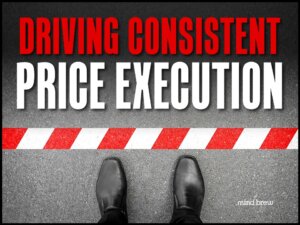When we ask pricing teams about their biggest frustrations, we hear some consistent themes. Probably the most constant complaint is that sales teams don’t comply with pricing guidance.
Pricing spends a lot of time developing segments and models. We then deliver the best possible prices to teams in the field, only to have them break the rules and go with their gut instinct.
That’s infuriating for pricing professionals. After all, we are the gatekeepers of profitiability. We work really hard to develop models that reflect current market realities while insuring that the company stays in business. In a real sense, our work is what enables the rest of the employees to have a job.
And sales just totally ignores all that. They undermine our best guidance, putting their desire to close deals above everything else. The end result is that they sabotage not only the pricing team, but the entire company.
But what if it’s not the sales team’s fault?
What if the real problem lies with the system that the salespeople are operating within. The truth is that they are responding to realities that they encounter in the field—realities that may not be fully captured in our pricing models.
Yes, sometimes you have a salesperson who’s just a pigheaded jerk who won’t listen to reason. But in our experience, it’s more often the case that lack of compliance with sales guidance is a symptom of a deeper problem.
Instead of immediately blowing up at the sales team, the next time someone disregards your guidance, investigate the systemic factors that led to that result. Are you not communicating the prices clearly enough? Is the sales comp plan set up in such a way that it encourages bad behavior? Is there a flaw in your pricing model that is out of step with reality in the field?
If you want to get sales to do a better job with pricing, you need to figure out the root cause of the problem and fix it. Only then will you achieve the alignment between sales and pricing that you are hoping for.
If you’re not sure where to start with that root-cause analysis, we have some resources that can help:
- Driving Consistent Price Execution explains how to reinforce and support your pricing guidance. It also offers proven approaches for encouraging better behaviors, including “carrots and sticks” and technology.
- Making Pricing More Responsive offers strategies and tactics for improving your agility. If your sales team complains that your prices are out of touch with the market, this webinar is a good place to start.
- Getting Sales to Sell the Value lays out five conditions that need to be in place to get your team to consistently comply with pricing guidance. It also offers some strategies for anticipating and overcoming resistance.
When you put this knowledge into practice, will it eliminate all conflict between sales and pricing?
Absolutely not.
We’ve never seen a company where the two teams had a completely frictionless relationship. But that’s actually a good thing. If you can avoid taking the criticism personally and recognize that the clashes are highlighting weak points in the system, you’ll be able to make significant improvements over time. While progress might be slow at first, you will eventually see greater compliance—and better business results.
















